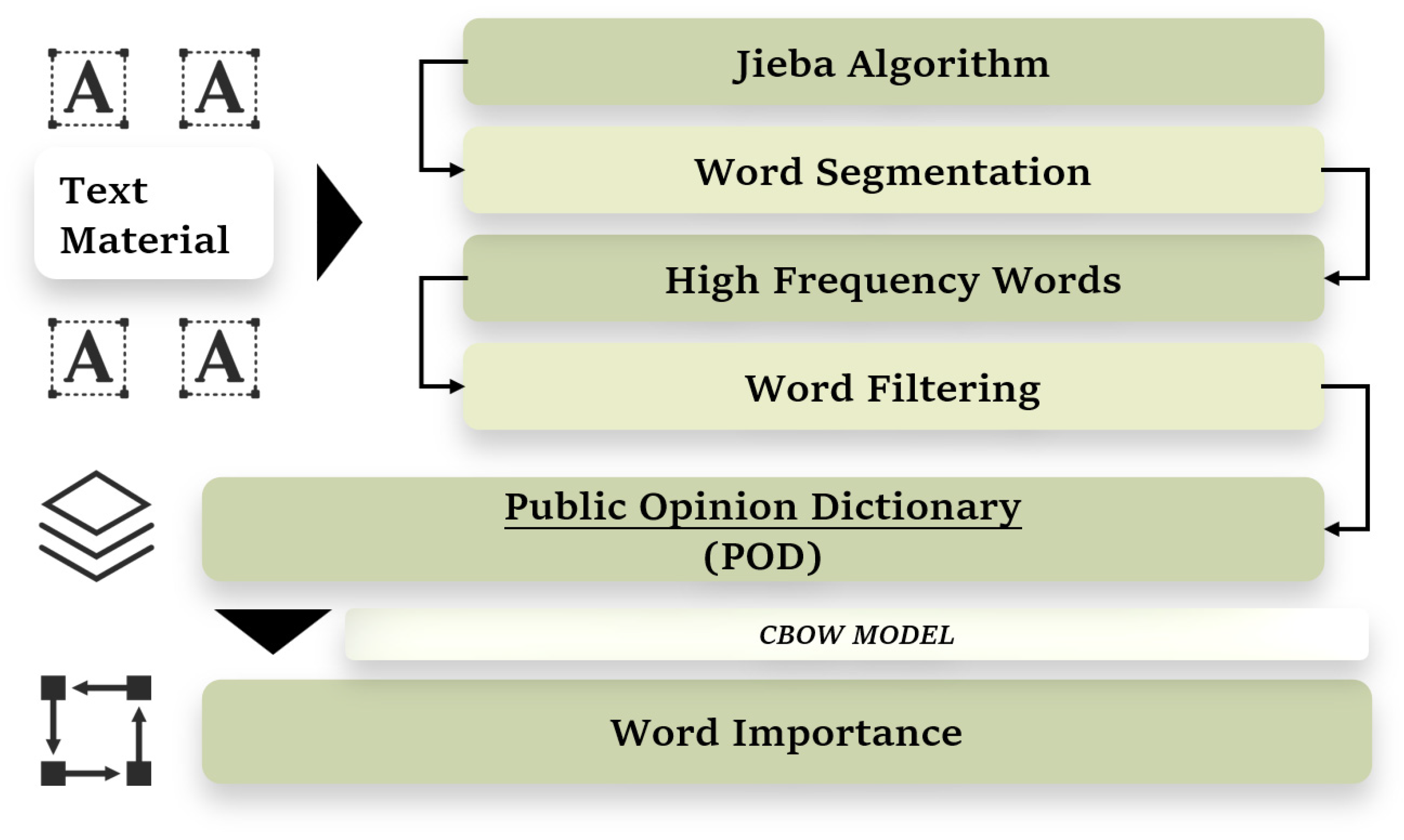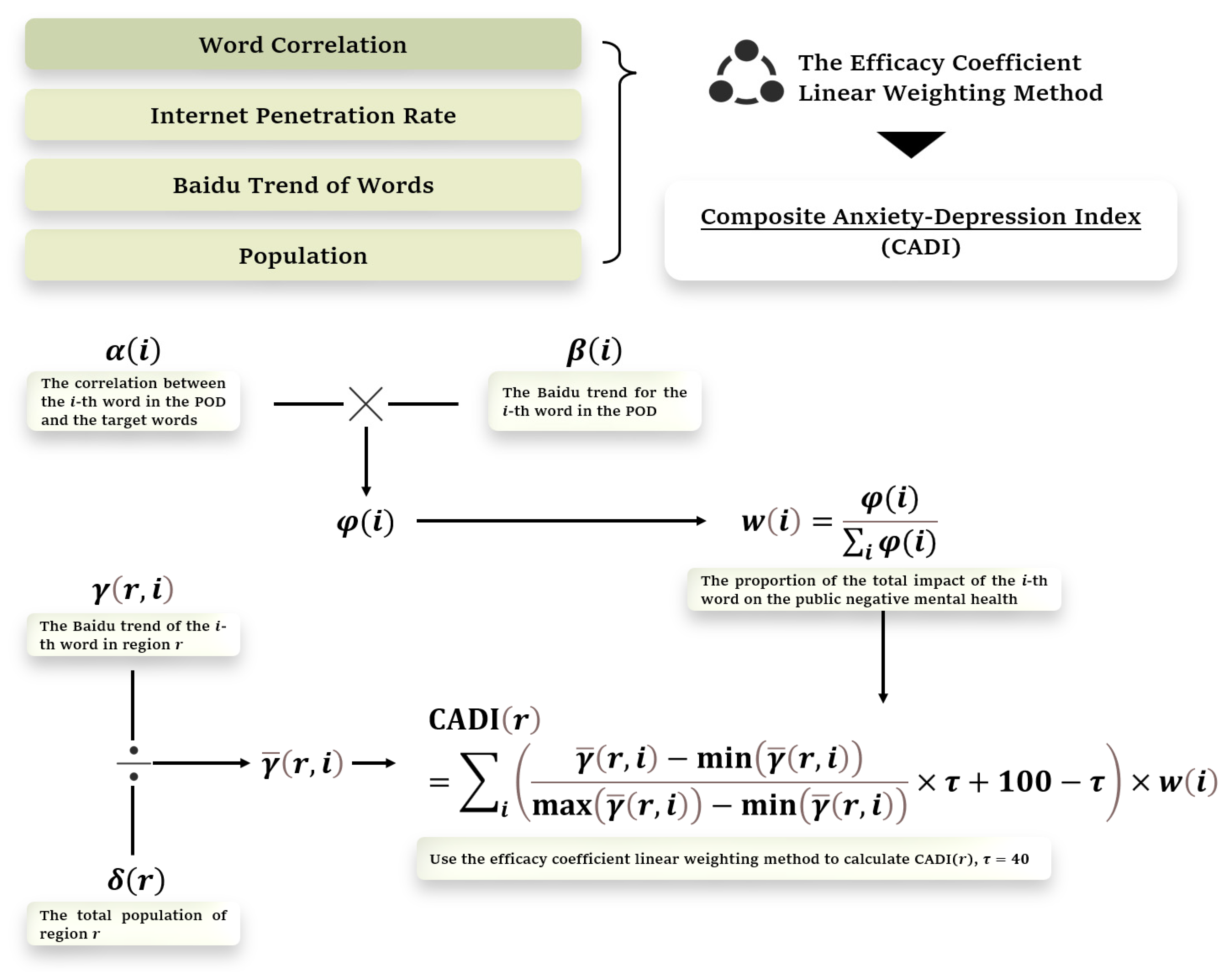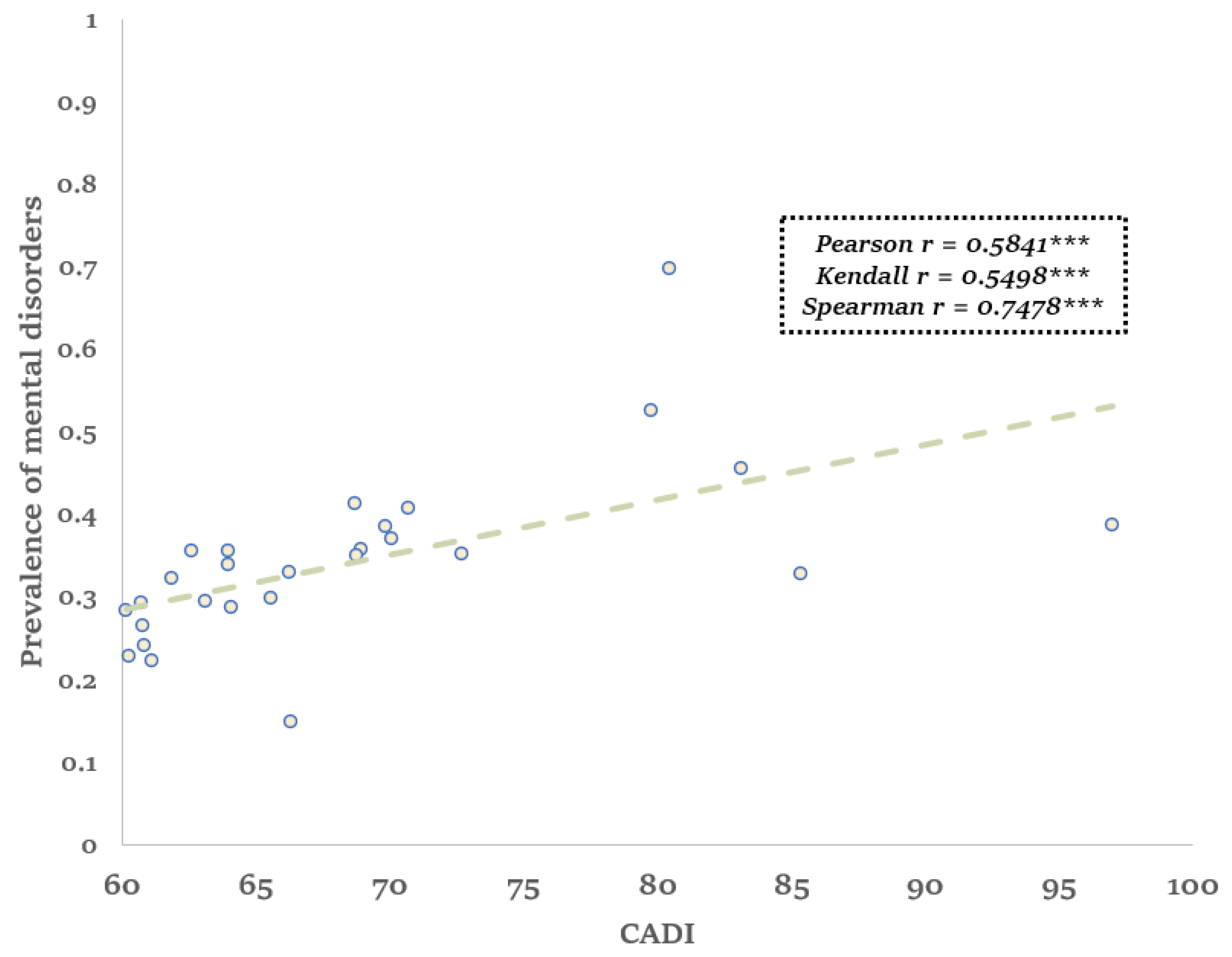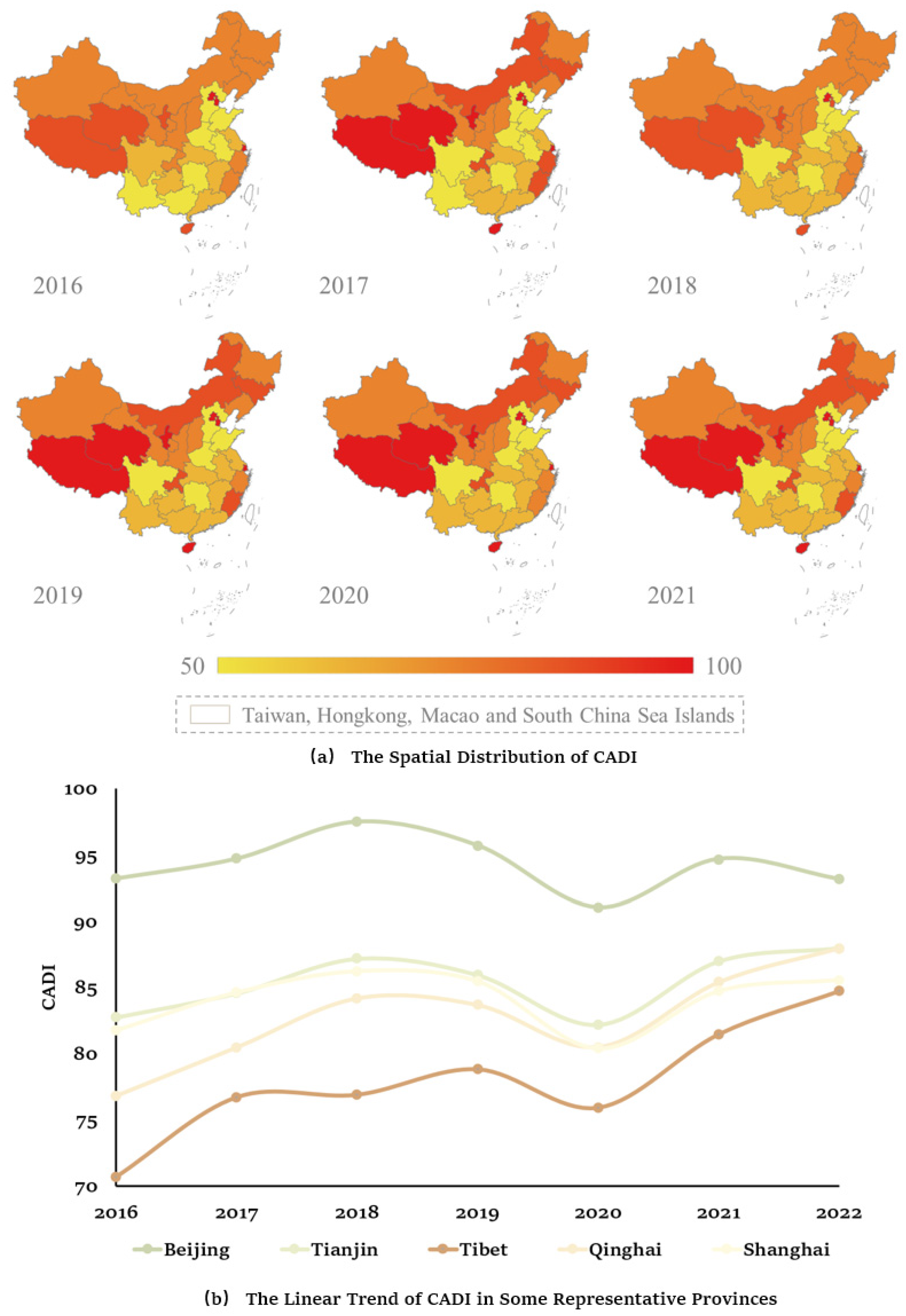A Fresh Perspective on Examining Population Emotional Well-Being Trends by Internet Search Engine: An Emerging Composite Anxiety and Depression Index
Abstract
1. Introduction
2. Methodology
2.1. Construction of the Composite Anxiety and Depression Index
2.1.1. Public Opinion Dictionary and Word Importance
2.1.2. Internet Search Trends
2.1.3. Calculation of the Composite Anxiety and Depression Index
2.2. Explanatory Variables for the Composite Anxiety and Depression Index
2.3. Modeling Strategy
3. Results
3.1. Correlation between CADI and Prevalence of Mental Disorders
3.2. Spatiotemporal Trends of CADI
3.3. Regression Model Results
4. Discussion
5. Conclusions
Supplementary Materials
Author Contributions
Funding
Institutional Review Board Statement
Informed Consent Statement
Data Availability Statement
Conflicts of Interest
References
- Barlow, D.H. Unraveling the Mysteries of Anxiety and Its Disorders from the Perspective of Emotion Theory. Am. Psychol. 2000, 55, 1247–1263. [Google Scholar] [CrossRef]
- Chen, B.; Ma, W.; Pan, Y.; Guo, W.; Chen, Y. PM2.5 Exposure and Anxiety in China: Evidence from the Prefectures. BMC Public Health 2021, 21, 429. [Google Scholar] [CrossRef]
- Li, J.; Yang, Z.; Qiu, H.; Wang, Y.; Jian, L.; Ji, J.; Li, K. Anxiety and Depression among General Population in China at the Peak of the COVID-19 Epidemic. World Psychiatry 2020, 19, 249–250. [Google Scholar] [CrossRef]
- Penninx, B.W.J.H.; Pine, D.S.; Holmes, E.A.; Reif, A. Anxiety Disorders. Lancet 2021, 397, 914–927. [Google Scholar] [CrossRef]
- Santomauro, D.F.; Herrera, A.M.M.; Shadid, J.; Zheng, P.; Ashbaugh, C.; Pigott, D.M.; Abbafati, C.; Adolph, C.; Amlag, J.O.; Aravkin, A.Y.; et al. Global Prevalence and Burden of Depressive and Anxiety Disorders in 204 Countries and Territories in 2020 Due to the COVID-19 Pandemic. Lancet 2021, 398, 1700–1712. [Google Scholar] [CrossRef]
- Hameleers, M. Prospect Theory in Times of a Pandemic: The Effects of Gain versus Loss Framing on Risky Choices and Emotional Responses during the 2020 Coronavirus Outbreak—Evidence from the US and the Netherlands. Mass Commun. Soc. 2021, 24, 479–499. [Google Scholar] [CrossRef]
- Lin, X.-H.; Teng, S.; Wang, L.; Zhang, J.; Shang, Y.-B.; Liu, H.-X.; Zang, Y.-J. Fatigue and Its Associated Factors in Liver Transplant Recipients in Beijing: A Cross-Sectional Study. BMJ Open 2017, 7, e011840. [Google Scholar] [CrossRef]
- Jia, Z.; Wei, Y.; Li, X.; Yang, L.; Liu, H.; Guo, C.; Zhang, L.; Li, N.; Guo, S.; Qian, Y.; et al. Exposure to Ambient Air Particles Increases the Risk of Mental Disorder: Findings from a Natural Experiment in Beijing. Int. J. Environ. Res. Public Health 2018, 15, 160. [Google Scholar] [CrossRef]
- Feldstein, M. Underestimating the Real Growth of GDP, Personal Income, and Productivity. J. Econ. Perspect. 2017, 31, 145–164. [Google Scholar] [CrossRef]
- Bystritsky, A.; Khalsa, S.S.; Cameron, M.E.; Schiffman, J. Current Diagnosis and Treatment of Anxiety Disorders. Pharm. Ther. 2013, 38, 30–57. [Google Scholar]
- Smith, K.M.; Renshaw, P.F.; Bilello, J. The Diagnosis of Depression: Current and Emerging Methods. Compr. Psychiatry 2013, 54, 1–6. [Google Scholar] [CrossRef] [PubMed]
- Wood, L.; Birtel, M.; Alsawy, S.; Pyle, M.; Morrison, A. Public Perceptions of Stigma towards People with Schizophrenia, Depression, and Anxiety. Psychiatry Res. 2014, 220, 604–608. [Google Scholar] [CrossRef]
- Huang, Y.; Wang, Y.; Wang, H.; Liu, Z.; Yu, X.; Yan, J.; Yu, Y.; Kou, C.; Xu, X.; Lu, J.; et al. Prevalence of Mental Disorders in China: A Cross-Sectional Epidemiological Study. Lancet Psychiatry 2019, 6, 211–224. [Google Scholar] [CrossRef]
- Huang, Y.; Liu, Z.; Wang, H.; Guan, X.; Chen, H.; Ma, C.; Li, Q.; Yan, J.; Yu, Y.; Kou, C.; et al. The China Mental Health Survey (CMHS): I. Background, Aims and Measures. Soc. Psychiatry Psychiatr. Epidemiol. 2016, 51, 1559–1569. [Google Scholar] [CrossRef]
- Chae, J.; Thom, D.; Jang, Y.; Kim, S.; Ertl, T.; Ebert, D.S. Public Behavior Response Analysis in Disaster Events Utilizing Visual Analytics of Microblog Data. Comput. Graph. 2014, 38, 51–60. [Google Scholar] [CrossRef]
- Han, X.; Wang, J.; Zhang, M.; Wang, X. Using Social Media to Mine and Analyze Public Opinion Related to COVID-19 in China. Int. J. Environ. Res. Public Health 2020, 17, 2788. [Google Scholar] [CrossRef] [PubMed]
- AminiMotlagh, M.; Shahhoseini, H.; Fatehi, N. A Reliable Sentiment Analysis for Classification of Tweets in Social Networks. Soc. Netw. Anal. Min. 2023, 13, 7. [Google Scholar] [CrossRef]
- Di Cara, N.H.; Maggio, V.; Davis, O.S.P.; Haworth, C.M.A. Methodologies for Monitoring Mental Health on Twitter: Systematic Review. J. Med. Internet Res. 2023, 25, e42734. [Google Scholar] [CrossRef] [PubMed]
- Ramsawak, R.; Mohan, P.; Hutchinson, G. Understanding Mental Health Conditions and Key Coping Strategies Utilized during Major Lockdowns in the Caribbean Based on Google Trends Searches. Heliyon 2023, 9, e19843. [Google Scholar] [CrossRef]
- Wang, S.-C.; Chen, Y.-C. Exploration of Correlations between COVID-19 Vaccination Choice and Public Mental Health Using Google Trend Search. Vaccines 2022, 10, 2173. [Google Scholar] [CrossRef]
- Sycińska-Dziarnowska, M.; Szyszka-Sommerfeld, L.; Kłoda, K.; Simeone, M.; Woźniak, K.; Spagnuolo, G. Mental Health Interest and Its Prediction during the COVID-19 Pandemic Using Google Trends. Int. J. Environ. Res. Public Health 2021, 18, 12369. [Google Scholar] [CrossRef]
- Steiger, E.; Resch, B.; Zipf, A. Exploration of Spatiotemporal and Semantic Clusters of Twitter Data Using Unsupervised Neural Networks. Int. J. Geogr. Inf. Sci. 2016, 30, 1694–1716. [Google Scholar] [CrossRef]
- Li, A.; Yi, S. Emotion Analysis Model of Microblog Comment Text Based on CNN-BiLSTM. Comput. Intell. Neurosci. 2022, 2022, e1669569. [Google Scholar] [CrossRef]
- da Silva, B.B.C.; Paraboni, I. Personality Recognition from Facebook Text. In Processings of the International Conference on Computational Processing of the Portuguese Language, PROPOR 2018, Canela, Brazil, 24–26 September 2018; Villavicencio, A., Moreira, V., Abad, A., Caseli, H., Gamallo, P., Ramisch, C., Gonçalo Oliveira, H., Paetzold, G.H., Eds.; Springer International Publishing: Cham, Switzerland, 2018; pp. 107–114. [Google Scholar]
- Goldberg, L.R. An Alternative “Description of Personality”: The Big-Five Factor Structure. J. Pers. Soc. Psychol. 1990, 59, 1216–1229. [Google Scholar] [CrossRef]
- Cheng, Q.; Lui, C.S.M. Applying Text Mining Methods to Suicide Research. Suicide Life-Threat. Behav. 2021, 51, 137–147. [Google Scholar] [CrossRef]
- Junyi, S. Jieba, Version 0.42.1, Jieba: Chinese Words Segmentation Utilities. 2020. Available online: https://pypi.org/project/jieba/ (accessed on 6 February 2024).
- Mikolov, T.; Chen, K.; Corrado, G.; Dean, J. Efficient Estimation of Word Representations in Vector Space. arXiv 2013, arXiv:1301.3781. [Google Scholar]
- Wang, Y.; Jing, H.; Han, L.; Yu, L.; Zhang, Q. Risk Analysis on Swell–Shrink Capacity of Expansive Soils with Efficacy Coefficient Method and Entropy Coefficient Method. Appl. Clay Sci. 2014, 99, 275–281. [Google Scholar] [CrossRef]
- Paul, K.I.; Moser, K. Unemployment Impairs Mental Health: Meta-Analyses. J. Vocat. Behav. 2009, 74, 264–282. [Google Scholar] [CrossRef]
- Pharr, J.R.; Moonie, S.; Bungum, T.J. The Impact of Unemployment on Mental and Physical Health, Access to Health Care and Health Risk Behaviors. Int. Sch. Res. Not. 2011, 2012, e483432. [Google Scholar] [CrossRef]
- Warr, P.; Jackson, P.; Banks, M. Unemployment and Mental Health: Some British Studies. J. Soc. Issues 1988, 44, 47–68. [Google Scholar] [CrossRef]
- Li, P.; Zhao, Y.; Fan, X.; Wang, J.; Lu, W.; Zheng, X. Independent Associations of Serum 25-Hydroxyvitamin D3 and D2 with Depressive Symptoms in Females. J. Affect. Disord. 2022, 296, 342–349. [Google Scholar] [CrossRef] [PubMed]
- Zhang, T.; Luo, Z.-C.; Ji, Y.; Chen, Y.; Ma, R.; Fan, P.; Tang, N.; Li, J.; Tian, Y.; Zhang, J.; et al. The Impact of Maternal Depression, Anxiety, and Stress on Early Neurodevelopment in Boys and Girls. J. Affect. Disord. 2023, 321, 74–82. [Google Scholar] [CrossRef] [PubMed]
- Zhao, Y.; Strauss, J.; Chen, X.; Wang, Y.; Gong, J.; Meng, Q.; Wang, G.; Wang, H. China Health and Retirement Longitudinal Study Wave 4 User’s Guide; National School of Development, Peking University: Beijing, China, 2020; pp. 5–6. [Google Scholar]
- Sokka, T.; Kautiainen, H.; Pincus, T.; Toloza, S.; Pinheiro, G.d.R.C.; Lazovskis, J.; Hetland, M.L.; Peets, T.; Immonen, K.; Maillefert, J.F.; et al. Disparities in Rheumatoid Arthritis Disease Activity According to Gross Domestic Product in 25 Countries in the QUEST–RA Database. Ann. Rheum. Dis. 2009, 68, 1666–1672. [Google Scholar] [CrossRef] [PubMed]
- Nisar, A.; Yin, J.; Waqas, A.; Bai, X.; Wang, D.; Rahman, A.; Li, X. Prevalence of Perinatal Depression and Its Determinants in Mainland China: A Systematic Review and Meta-Analysis. J. Affect. Disord. 2020, 277, 1022–1037. [Google Scholar] [CrossRef] [PubMed]
- Ren, Y.; Qian, W.; Li, Z.; Liu, Z.; Zhou, Y.; Wang, R.; Qi, L.; Yang, J.; Song, X.; Zeng, L.; et al. Public Mental Health under the Long-Term Influence of COVID-19 in China: Geographical and Temporal Distribution. J. Affect. Disord. 2020, 277, 893–900. [Google Scholar] [CrossRef] [PubMed]
- Li, F.; Cui, Y.; Li, Y.; Guo, L.; Ke, X.; Liu, J.; Luo, X.; Zheng, Y.; Leckman, J.F. Prevalence of Mental Disorders in School Children and Adolescents in China: Diagnostic Data from Detailed Clinical Assessments of 17,524 Individuals. J. Child Psychol. Psychiatry 2022, 63, 34–46. [Google Scholar] [CrossRef] [PubMed]
- Kahneman, D.; Deaton, A. High Income Improves Evaluation of Life but Not Emotional Well-Being. Proc. Natl. Acad. Sci. USA 2010, 107, 16489–16493. [Google Scholar] [CrossRef]
- Wu, T.; Perrings, C.; Kinzig, A.; Collins, J.P.; Minteer, B.A.; Daszak, P. Economic Growth, Urbanization, Globalization, and the Risks of Emerging Infectious Diseases in China: A Review. Ambio 2017, 46, 18–29. [Google Scholar] [CrossRef]
- Shi, L.; Lu, Z.-A.; Que, J.-Y.; Huang, X.-L.; Liu, L.; Ran, M.-S.; Gong, Y.-M.; Yuan, K.; Yan, W.; Sun, Y.-K.; et al. Prevalence of and Risk Factors Associated With Mental Health Symptoms Among the General Population in China During the Coronavirus Disease 2019 Pandemic. JAMA Netw. Open 2020, 3, e2014053. [Google Scholar] [CrossRef]
- Sun, J.; Lyu, S. The Effect of Medical Insurance on Catastrophic Health Expenditure: Evidence from China. Cost Eff. Resour. Alloc. 2020, 18, 10. [Google Scholar] [CrossRef]
- Goss, P.E.; Strasser-Weippl, K.; Lee-Bychkovsky, B.L.; Fan, L.; Li, J.; Chavarri-Guerra, Y.; Liedke, P.E.R.; Pramesh, C.S.; Badovinac-Crnjevic, T.; Sheikine, Y.; et al. Challenges to Effective Cancer Control in China, India, and Russia. Lancet Oncol. 2014, 15, 489–538. [Google Scholar] [CrossRef]
- Virgolino, A.; Costa, J.; Santos, O.; Pereira, M.E.; Antunes, R.; Ambrósio, S.; Heitor, M.J.; Vaz Carneiro, A. Lost in Transition: A Systematic Review of the Association between Unemployment and Mental Health. J. Ment. Health 2022, 31, 432–444. [Google Scholar] [CrossRef] [PubMed]
- Saurina, C.; Marzo, M.; Saez, M. Inequalities in Suicide Mortality Rates and the Economic Recession in the Municipalities of Catalonia, Spain. Int. J. Equity Health 2015, 14, 75. [Google Scholar] [CrossRef] [PubMed][Green Version]
- Morgan, J.; Robinson, O.; Thompson, T. Happiness and Age in European Adults: The Moderating Role of Gross Domestic Product per Capita. Psychol. Aging 2015, 30, 544–551. [Google Scholar] [CrossRef] [PubMed]




| LRM | QRM | |||||
|---|---|---|---|---|---|---|
| Group | Overall | Subgroup1 | Subgroup2 | Overall | Subgroup1 | Subgroup2 |
| Economic Development | ||||||
| DI | −1.587 | −28.389 *** | 1.588 | 1.066 | −23.367 ** | 1.366 |
| CPI | 0.142 | 0.388 | −0.073 | 0.201 | 0.634 | −0.007 |
| CGR | −2.568 | −23.537 | −7.069 | −14.783 | −37.098 | −15.386 |
| IE | −16.272 *** | −9.167 ** | 13.329 | −13.490 *** | −11.600 ** | 12.852 |
| Medical Burden | ||||||
| ACP | 4.412 *** | 8.210 *** | 3.965 *** | 3.697 *** | 6.132 *** | 3.951 *** |
| RHE | −0.005 | 0.100 | −0.215 | −0.951 | −0.982 | −1.218 |
| RD | 21.961 | 33.769 | 120.374 | 112.412 | 66.792 | 189.614 |
| RU | −0.697 | −1.782 | 2.399 ** | −0.84 | 1.934 | 3.867 * |
| year2 | 1.102 | −12.074 ** | 12.836 *** | 5.105 | −13.183 * | 13.704 |
| year3 | 6.902 ** | −4.011 | 10.477 *** | 9.504 ** | −4.434 | 11.523 |
| year4 | 6.383 ** | −1.592 | 9.692 *** | 7.879 ** | −3.466 | 12.109 * |
| year5 | 2.947 | −0.056 | 8.974 *** | 4.616 | 0.268 | 11.361 |
| _cons | 49.176 * | 84.993 * | 12.51 | 43.749 | 67.618 | 9.737 |
| R-squared | 0.674 | 0.577 | 0.871 | - | - | - |
Disclaimer/Publisher’s Note: The statements, opinions and data contained in all publications are solely those of the individual author(s) and contributor(s) and not of MDPI and/or the editor(s). MDPI and/or the editor(s) disclaim responsibility for any injury to people or property resulting from any ideas, methods, instructions or products referred to in the content. |
© 2024 by the authors. Licensee MDPI, Basel, Switzerland. This article is an open access article distributed under the terms and conditions of the Creative Commons Attribution (CC BY) license (https://creativecommons.org/licenses/by/4.0/).
Share and Cite
Wang, Y.; Deng, H.; Gao, S.; Li, T.; Wang, F. A Fresh Perspective on Examining Population Emotional Well-Being Trends by Internet Search Engine: An Emerging Composite Anxiety and Depression Index. Int. J. Environ. Res. Public Health 2024, 21, 202. https://doi.org/10.3390/ijerph21020202
Wang Y, Deng H, Gao S, Li T, Wang F. A Fresh Perspective on Examining Population Emotional Well-Being Trends by Internet Search Engine: An Emerging Composite Anxiety and Depression Index. International Journal of Environmental Research and Public Health. 2024; 21(2):202. https://doi.org/10.3390/ijerph21020202
Chicago/Turabian StyleWang, Yu, Heming Deng, Sunan Gao, Tongxu Li, and Feifei Wang. 2024. "A Fresh Perspective on Examining Population Emotional Well-Being Trends by Internet Search Engine: An Emerging Composite Anxiety and Depression Index" International Journal of Environmental Research and Public Health 21, no. 2: 202. https://doi.org/10.3390/ijerph21020202
APA StyleWang, Y., Deng, H., Gao, S., Li, T., & Wang, F. (2024). A Fresh Perspective on Examining Population Emotional Well-Being Trends by Internet Search Engine: An Emerging Composite Anxiety and Depression Index. International Journal of Environmental Research and Public Health, 21(2), 202. https://doi.org/10.3390/ijerph21020202





